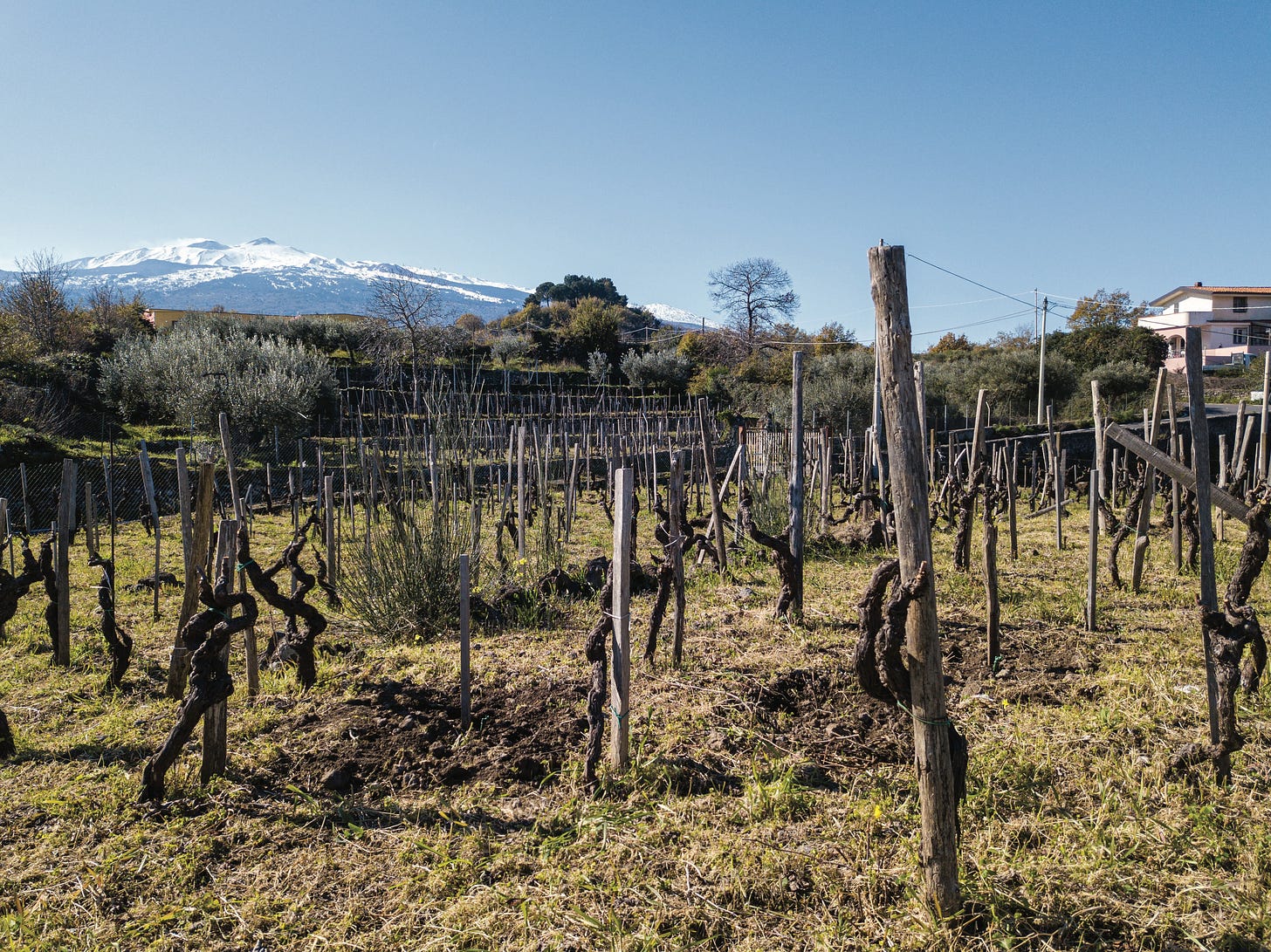Etna mountain and its wines
Isn’t it dangerous for wine production?
The last weeks Mount Etna has been showing her strength with activity and even an eruption on the 4th of August. Some wine lovers asked if it does not bring the vineyards of the Etna Nord wines in danger… well yes and no. There is an intense love and hate relationship between wine and the volcano since the extreme uniqueness of the wines is due to the volcano activity and not in spite off, but that same activity is always a danger to the existence of the vineyards. Volcanic wines are exciting and a must try for every wine lover or might even make you fall in love with wine.
Credits: Davide di Bella from Produttori Etna Nord
How to flourish on volcanic ashes
Producing wine on an active volcano is not for the faint hearted. But the activity of this tall lady is a blessing as the soils are fertile. The eruptions deposit a layer of volcanic ashes and pumice on the surrounding lands which leads to soils rich in minerals such as iron, magnesium, potassium, and calcium. These minerals are very beneficial to the grapevines. In addition, Volcanic soils er typically well-drained and well-aerated and basically works as a natural irrigation system. Although eruptions can stress grapevines and lead to lower yields, history shows that the quality of the fruits continues to be high and results in intense and complex wines. But how do you deal with living on an active volcano? it is actually pretty simple: Vineyards are build on locations that are less prone to lava flows. And to protect the grapes from ash fall sometimes temporary constructions are used to limit damage. In the long term the lava and ashes enriches the soil and is key to the unique terroir what makes volcanic wines so special.
Credits: Davide Di Bella from Produttori Etna Nord
The prime spot: Etna Nord
Mount Etna can be separated in three key regions: North (Etna Nord), East (Etna Est) and south east (Etna Sud-Est).
Etna Nord: Elevation on this slope ranges from 500 – 1000 meters above sea level and has excellent drainage and mineral rich volcanic soils. The climate is cooler and experiences diurnal temperature variations which helps maintaining acidity and develop complex flavors in the grapes.
The wines from Etna Nord are known for its elegance, structure, and longevity. Red wines from Nerello Mascalese are often highly aromatic and complex.
Etna East: the climate here is a bit more humid and wetter due to the influence of the Ionian Sea. The soil is rich and fertile, and vineyards are at lower levels compared to Etna Nord.
Especially the white Carricante wines thrive on this part of the mountain. The wines are crisp, contain high acidity and minerality and floral aromas.
Etna Sud Est: the southern part of this wine region offers a warmer climate with many sun hours. Red wines from Nerello as and Nerello Cappuccio typically produce fruity and full-bodied wines while the whites from the Carricante grapes result in fresh and mineral driven wines.
All in all, the slopes that offer the best and highest quality wines are located on the Etna Nord, but it never hurts to try wines from the other slopes too.
Credits: Davide Di Bella from produttori Etna Nord
Local grapes and DOC appellation
A special place produces special products and that goes very much so for the vines on Mount Etna. There are four local grape varieties that are important to know as they are included in the Etna DOC appellation. Nerello Mascalese, Nerello Cappuccio, Catarratto & Carricante. The DOC appellation was introduced in 1968 with the most well-known DOC being Etna Bianco and Etna Rosso and Etna Rosato.
Etna Rosso is made from at least 80% Nerello Mascalese and up to 20% Nerello Cappuccio. The wines must be aged for at least 12 months and the maximum yield is set to 9t/ha.
Nerello Mascalese: a grape that produces pale wines with aromas of dried cherries, orange zest, thyme, and earthy tones. The wines are elegant and age worthy. The grapes almost exclusively grow on Mount Etna and how the wine eventually turns out depends on age of the vines, how they’re planted and of course: elevation.
Nerello Cappuccio: (Nerello Mantellato): the grapes produce aromatic wines and produces light colored wines with fresh acidity and a floral character.
Etna Bianco
The primary grape for Etna Bianco wines is at least 60% Carricante and up to 40% Catarratto. Carricante is a grape indigenous to Sicily and produces wines with high-acidity, freshness and minerality. The other grape, Catarratto which is often blended with Carricante, adds body and some more minerality. The grape brings citrus and floral notes. The maximum yield is set at 10t/ha.
Etna Bianco typically has a straw yellow color. The wines exhibit aromas like citrus fruits, green apple, white flowers, and herbs. There are also mineral and saline notes reflecting the volcanic terroir. On the palate the wines are known for its high acidity, crispness and refreshing qualities. Flavors include green apple, pear, and sometimes even tropical fruits. Etna Bianco wines often have a long and clean finish.
The combination of the old vines, with unique local grapes and the fertile volcanic soil make wines from Mount Etna an experience on its own. And a must have for each wine lover. So, let’s taste!





